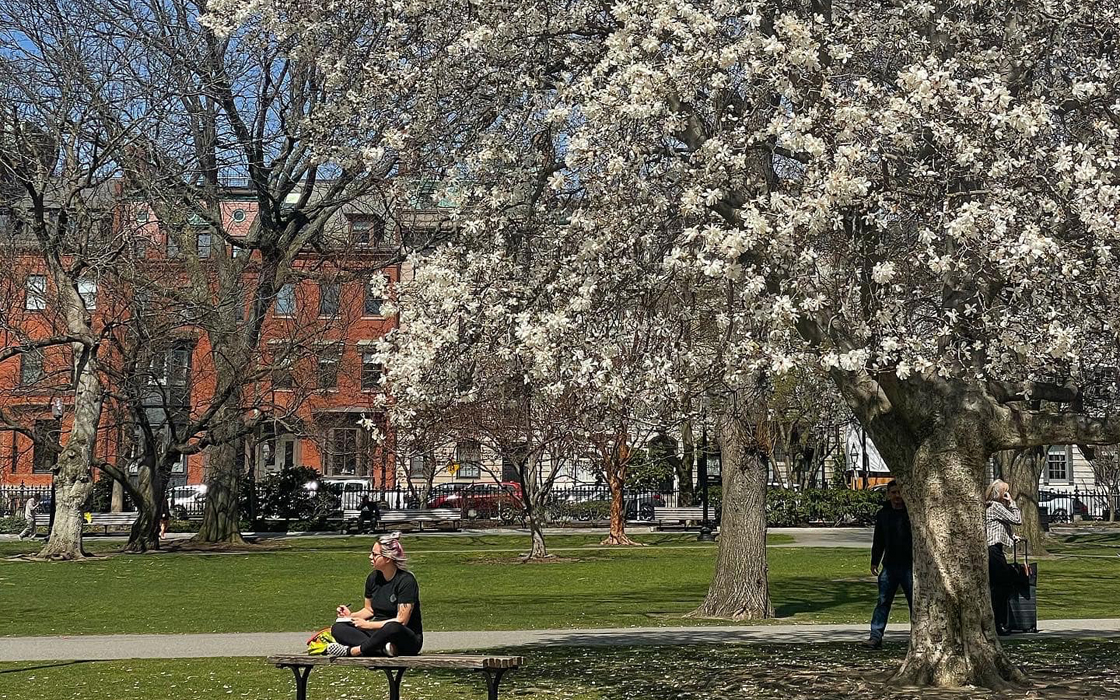
With their large showy flowers, sweet heady fragrance, and glossy green leaves, Magnolias are one some of the most beloved flowering trees. There are twelve of these ever-popular ornamental trees in the Public Garden, and they also line many blocks of the Commonwealth Avenue Mall, showing a preference for the sunnier side.
Magnolias can be a bit picky when it comes to soil and sunlight, and once rooted they are difficult to move. Throughout the fall and winter, you can identify Magnolias by their large flower buds that are “fuzzy” to insulate them from the cold. They blossom in the spring with large stunning petals alerting everyone to the coming warmth in late May and early June. Magnolia flowers are actually composed of “tepals,” a combination of sepals and petals similar in size and shape to water lilies. While the Magnolia is best known for its flowers, its foliage and fruit are also very attractive.
The genus Magnolia includes about 225 species native to North and South America, the Himalayas, and East Asia. They come in a wide array of cultivars that can suit the scale of any greenspace. Sizes range from 15-foot shrubs to massive trees that can reach heights of 80 feet or more and, interestingly, they can be evergreen or deciduous. Eight species of Magnolias—two evergreen and six deciduous—are native to the United States. These native species have proven quite adaptable and many can flourish in places outside their natural growing zone, particularly the deciduous varieties, which can be grown in almost any region of the U.S., from the tip of Florida to as far north as Maine and Washington. Despite their adaptability to cooler climes, they have come to symbolize the southern United States, where the tree serves as state tree for both Mississippi and Louisiana.

We have six species of Magnolia in the Garden (see map for locations):
Of the Magnolias in the Public Garden the star is the cold-hardy Star Magnolia (Magnolia stellata) with large starburst-shaped pink blooms to delight the public.
The Saucer Magnolia, (Magnolia X soulangeana), a large-flowering tree with white, pink, or purple fragrant flowers, attracts songbirds and beetle pollinators.
Another popular ornamental magnolia is the Sweetbay Magnolia, (Magnolia virginiana) with its creamy white, lemon-scented flowers that appear in early summer. Each flower will open in the morning and close at night, lasting for around two or three days before falling from the tree.
The Green Shadow Sweetbay Magnolia, (Magnolia virginiana ‘Green Shadow’) features the fragrant white blooms of the species during a long flowering period. This species is one of the few magnolias that will tolerate swampy conditions.
We have one Elizabeth Magnolia, (Magnolia ‘Elizabeth’) a smaller tree with large, fragrant, primrose-yellow blooms in spring.
And the Yellow Fever Magnolia, (Magnolia stellata ‘Yellow Fever’) is a small upright tree with large, pale-yellow flowers that are flushed pink and appear before the foliage
In the same Family as the Magnolias are Tulip Trees (Liriodendron tulipifera), native to North America and the tallest eastern hardwood. It can grow to 80-100 feet in the deep forests of the Appalachian Mountains with no limbs, making it a very valuable timber tree. In the spring, the tulip tree will bloom with yellowish green to orange cupped fragrant flowers, 2 to 3 inches in diameter covering the plant. The plant is attractive to numerous pollinating insects and birds. Adding to the tulip image, the leaves are also tulip shaped. The tulip tree is the state tree of three states: Indiana, Kentucky and Tennessee.

